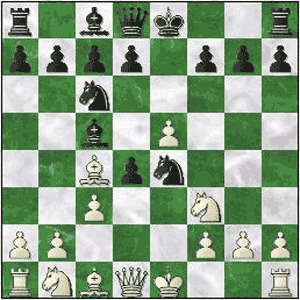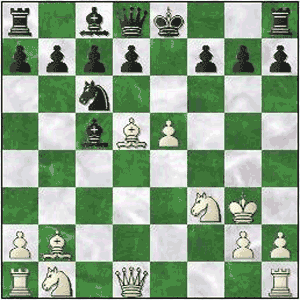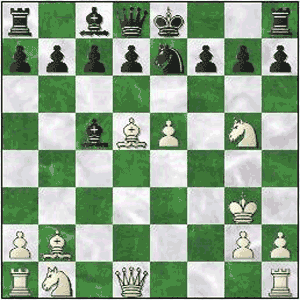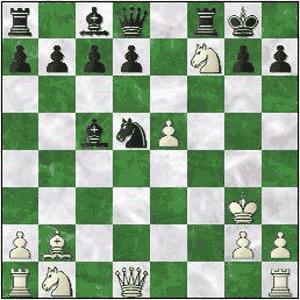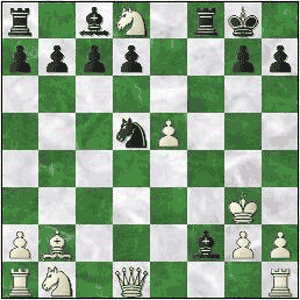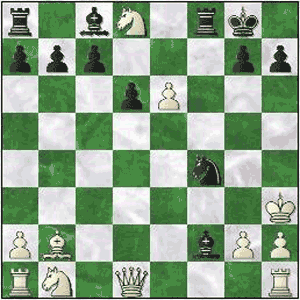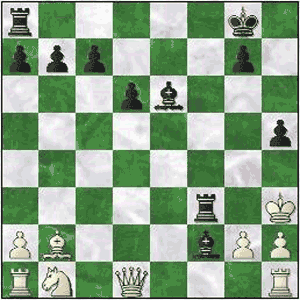| Back to Back Issues Page |
 |
|
LCB, Issue #042 --, Enjoy this Romantic Era Chess Classic November 01, 2018 |
Chess Classic from the Romantic EraLapoc Chess Board, Issue #042 -- GOTM #11 learn and play online chess We find ourselves in Warsaw in the middle of the 19th Century. This is chess played in a time before rock solid defensive techniques. Attacks were initiated from the first couple of moves, even before development was complete! Hoffmann and Petrov played this game in 1844. True to the traditions of the day, the game was personified by tactics against both Kings early on. Who won the race to checkmate? Players in this age were cool under fire when their King was in the cross-hairs of the enemy pieces. They simply responded with a counter-attack of their own. The game would be decided by the quickest attack of sufficient force. Lets see who won the race here. Chess Classic from the Romantic EraHoffmann, F - Petrov, Alexander [C53]GotM #11 - Warsaw, 1844 1.e4 e5 2.Nf3 Nc6 3.Bc4 Italian Game 3...Bc5 Giuoco Piano 4.c3 to support the d4 push 4...Nf6 5.d4 White plays for time and space. 5...exd4 6.e5 (6.cxd4 is playable but doesn't follow the logic of 5.d4. 6...Bb4+ 7.Nbd2 d5 8.exd5 Nxd5 9.0-0 0-0 10.Ne5 Be6 11.Ne4 Na5 12.Bd3= and both sides have everything to play for.) 6...Ne4?!
sacrifices the piece for 3 pawns. (6...d5 is much more popular... 7.Bb5 (7.exf6 dxc4 8.fxg7 Rg8-/+) 7...Ne4 8.cxd4 Bb4+ 9.Bd2 Nxd2 10.Nbxd2 0-0 11.0-0+/=; 6...Ng4? 7.cxd4 Bb4+ 8.Kf1 d5 9.Bd3 f6 10.h3 fxe5 11.hxg4 e4 12.Nc3 Bxc3 13.bxc3 Bxg4 14.Qe1 0-0 15.Nh2 exd3 16.Nxg4 Qe8 17.Qd1 Qe4 18.Rh3 Rae8 19.Re3 Qf5 20.f3+-; 6...Nh5? 7.cxd4 d5 8.Bb3 Be7 9.h3 g6 10.Bh6 Rg8 11.g4 Ng7 12.Qd2 Be6 13.Ba4 Qd7 14.Nc3 0-0-0 15.0-0-0 Kb8 16.Rhe1 a6 17.Ng5) 7.Bd5 Nxf2 8.Kxf2 dxc3+ The discovered check allows the acquisition of another pawn. 9.Kg3 Looks like bravado for the roaming monarch to lead from the front but it is as good as any alternative. (9.Kf1 is another way to play, 9...cxb2 10.Bxb2 0-0 11.Nc3 Nb4 12.Be4+/- and even though his King is out in the open and his King's Rook is out of the game, White's four centralized minor pieces and space advantage gives him an advantage.) 9...cxb2 10.Bxb2
White has a Knight for 3 pawns and the advantage but he must play accurately. His King is vulnerable. 10...Ne7 11.Ng5?
This move not only wipes out his edge but actually gives Black a won game. (11.Be4 holds the advantage. Play could continue with 11...f5 (11...d5 isn't so good: 12.exd6 cxd6 13.Bd3 Qb6 14.Qe2 d5 15.Rc1 0-0 16.Rxc5 Qxc5 17.Qc2 (17.Ba3 is dealt with by 17...Qc7+ 18.Kf2 Re8-/+) 17...Qxc2 18.Bxc2 Be6=/+ with Black slightly better.) 12.exf6 gxf6 13.Bd4 Bxd4 14.Nxd4 d5 15.Bf3 c5 16.Ne2+/- and White's extra pawn is worth more than Black's vulnerable pawns.; 11.Ba3 might lead to 11...Nf5+ 12.Kf4 Bd4 13.Nxd4 Qh4+ 14.Kf3 Nxd4+ 15.Ke3 Nf5+ 16.Ke2 d6 17.g3 Qd4 18.Qxd4 Nxd4+ 19.Kf2 dxe5 20.Nc3 Nc2 21.Nb5 c6 22.Nc7+ Kd7 23.Be4 Nxa3 24.Nxa8 Nb5) 11...Nxd5 12.Nxf7 (12.Qxd5 Qxg5+ 13.Kh3 d6+ 14.e6 Qxd5 15.Re1 Bxe6+ 16.Rxe6+ Qxe6+ 17.Kg3 Qe3+ 18.Kh4 h5 19.g3 Qe6 20.h3 Qe7+ 21.Bf6 Qxf6#) 12...0-0!!
The Queen sacrifice is the key to victory. White, already in big trouble, should resist. (12...Qe7 Black is still winning but now White has a glimmer of a hope. 13.Qxd5 Rf8 14.Nd2 The f7-Knight is beyond saving, White must bring his other pieces into the game. 14...c6 Preparing to open the c8-h3 diagonal. This is catastrophic for White so he finds an ingenious to exchange his Knight and lock down the dangerous light-square Bishop. 15.Nd6+! Bxd6 (15...Kd8? Now the game is equal. 16.Qxc5 (16.Nxc8?? Bf2+ 17.Kh3 (17.Kg4 Qh4#) 17...Qh4#) 16...Qg5+ 17.Kh3 Qh5+ 18.Kg3 Qg5+=) 16.exd6 Qe3+ 17.Qf3 Rxf3+ 18.Nxf3 Kf8-/+ and Black should win in the end.; 12...Kxf7? 13.Qxd5+ Ke8 14.Qxc5) 13.Nxd8? Ironically the move that seals White's fate. His position was already lost of course but capturing the Queen gives Black a forced mating sequence. He executes the mating attack flawlessly. (13.Rf1 Rxf7 14.Rxf7 Qg5+; 13.Bc1 Rxf7 14.Rf1 Rxf1 15.Qxd5+ Kh8 16.Qxc5-+; 13.Qxd5 Rxf7-+ and White's exposed King won't last long.) 13...Bf2+!
Forget about the Knight, Black sets about snaring the King. (13...Rxd8?? ends Black's attack, handing the initiative to White who will soon have an overwhelming material advantage. 14.Qxd5+ Kh8 15.Qxc5 d5 16.e6 Bxe6 17.Re1 Rd6+- The outcome is not in doubt.) 14.Kh3 d6+ 15.e6 Might have been enough to repel the attack and gain the advantage had it not been for one resource. 15...Nf4+!
Excellent move to keep the attack going. White musn't be given time to bring his extra pieces into play. 16.Kg4 Nxe6 The discovered check seems to oblige a piece exchange. 17.Nxe6 Loses quickly but the alternatives only offer a slightly longer, lingering demise. (17.g3 would have staved off the inevitable for a few more moves, 17...Nxd8+ 18.Kh5 Rf5+ 19.Kg4 Rf6+ 20.Kh4 Rf4+ 21.Kg5 Ne6+ 22.Kh5 g6+ 23.Kh6 Be3 24.Bc1 Rh4#; Likewise 17.Nf7 postpones # for just a few more moves, 17...Rxf7 18.g3 Nd4+ 19.Kh5 Rf5+ 20.Kh4 Rf4+ 21.Kh5 g6+ 22.Kh6 Be3 23.Qb3+ Nxb3 24.Kg5 Re4+ 25.Kf6 Re6#) 17...Bxe6+ And now White will quickly succumb. 18.Kg5 Rf5+ 19.Kg4 h5+ 20.Kh3 Rf3#
0-1 Hoffmann - Petrov (Warsaw, 1844) P.S. If you do not have html based email software and you're using a text only system, you may find that the links are only partially highlighted and may not work. If this is the case, simply copy and paste the entire link into the browser and hit Enter. That should get you where you want to go. Comments, ideas, feedback? I'd be stoked to hear from you. Get in touch See you next month. Ken 
|
| Back to Back Issues Page |
